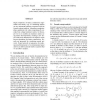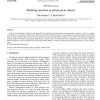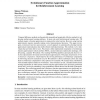872 search results - page 101 / 175 » Evolving Complex Neural Networks |
ECAL
2007
Springer
15 years 4 months ago
2007
Springer
Abstract. This paper investigates the processes used by an evolved, embodied simulated agent to adapt to large disruptive changes in its sensor morphology, whilst maintaining perfo...
CORR
2008
Springer
14 years 10 months ago
2008
Springer
A power law degree distribution is established for a graph evolution model based on the graph class of k-trees. This k-tree-based graph process can be viewed as an idealized model...
SYRCODIS
2007
14 years 11 months ago
2007
High complexity of lattice construction algorithms and uneasy way of visualising lattices are two important problems connected with the formal concept analysis. Algorithm complexi...
76
Voted
NN
2006
Springer
14 years 10 months ago
2006
Springer
Selective visual attention is believed to be responsible for serializing visual information for recognizing one object at a time in a complex scene. But how can we attend to objec...
CORR
2010
Springer
14 years 10 months ago
2010
Springer
Temporal difference methods are theoretically grounded and empirically effective methods for addressing reinforcement learning problems. In most real-world reinforcement learning ...



